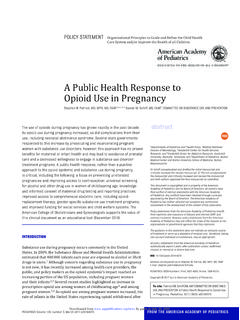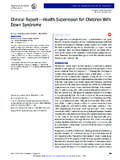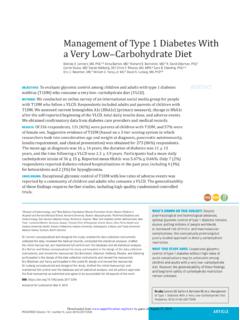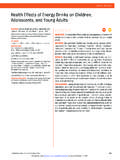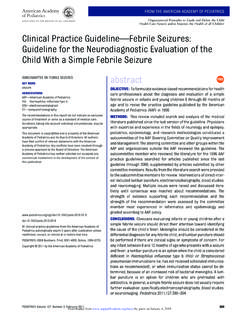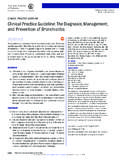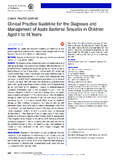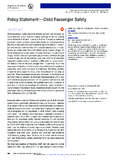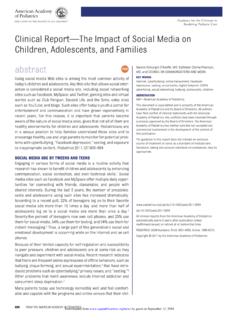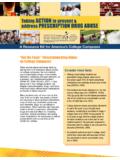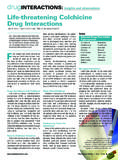Transcription of Brief Resolved Unexplained Events (Formerly Apparent Life ...
1 FROM THE AMERICAN ACADEMY OF PEDIATRICSPEDIATRICS Volume 137 , number 5 , May 2016 :e 20160590 Brief Resolved Unexplained Events ( formerly Apparent Life- threatening Events ) and Evaluation of Lower-Risk InfantsJoel S. Tieder, MD, MPH, FAAP, Joshua L. Bonkowsky, MD, PhD, FAAP, Ruth A. Etzel, MD, PhD, FAAP, Wayne H. Franklin, MD, MPH, MMM, FAAP, David A. Gremse, MD, FAAP, Bruce Herman, MD, FAAP, Eliot S. Katz, MD, FAAP, Leonard R. Krilov, MD, FAAP, J. Lawrence Merritt II, MD, FAAP, Chuck Norlin, MD, FAAP, Jack Percelay, MD, MPH, FAAP, Robert E. Sapi n, MD, MMM, FAAP, Richard N. Shiffman, MD, MCIS, FAAP, Michael Smith, MB, FRCPCH, FAAP, for the SUBCOMMITTEE ON Apparent LIFE threatening EVENTSThis document is copyrighted and is property of the American Academy of Pediatrics and its Board of Directors. All authors have fi led confl ict of interest statements with the American Academy of Pediatrics.
2 Any confl icts have been Resolved through a process approved by the Board of Directors. The American Academy of Pediatrics has neither solicited nor accepted any commercial involvement in the development of the content of this guidance in this report does not indicate an exclusive course of treatment or serve as a standard of medical care. Variations, taking into account individual circumstances, may be clinical practice guidelines from the American Academy of Pediatrics automatically expire 5 years after publication unless reaffi rmed, revised, or retired at or before that : (ISSN Numbers: Print, 0031-4005; Online, 1098-4275).Copyright 2016 by the American Academy of PediatricsabstractThis is the fi rst clinical practice guideline from the American Academy of Pediatrics that specifi cally applies to patients who have experienced an Apparent life- threatening event (ALTE).
3 This clinical practice guideline has 3 objectives. First, it recommends the replacement of the term ALTE with a new term, Brief Resolved Unexplained event (BRUE). Second, it provides an approach to patient evaluation that is based on the risk that the infant will have a repeat event or has a serious underlying disorder. Finally, it provides management recommendations, or key action statements, for lower-risk infants. The term BRUE is defi ned as an event occurring in an infant younger than 1 year when the observer reports a sudden, Brief , and now Resolved episode of 1 of the following: (1) cyanosis or pallor; (2) absent, decreased, or irregular breathing; (3) marked change in tone (hyper- or hypotonia); and (4) altered level of responsiveness. A BRUE is diagnosed only when there is no explanation for a qualifying event after conducting an appropriate history and physical examination.
4 By using this defi nition and framework, infants younger than 1 year who present with a BRUE are categorized either as (1) a lower-risk patient on the basis of history and physical examination for whom evidence-based recommendations for evaluation and management are offered or (2) a higher-risk patient whose history and physical examination suggest the need for further investigation and treatment but for whom recommendations are not offered. This clinical practice guideline is intended to foster a patient- and family-centered approach to care, reduce unnecessary and costly medical interventions, improve patient outcomes, support implementation, and provide direction for future research. Each key action statement indicates a level of evidence, the benefi t-harm relationship, and the strength of PRACTICE GUIDELINEG uidance for the Clinician in Rendering pediatric CareTo cite: Tieder JS, Bonkowsky JL, Etzel RA, et al.
5 Brief Resolved Unexplained Events ( formerly Apparent Life- threatening Events ) and Evaluation of Lower-Risk Infants. Pediatrics. 2016;137(5):e20160590 by guest on October 29, from FROM THE AMERICAN ACADEMY OF PEDIATRICSINTRODUCTIONThis clinical practice guideline applies to infants younger than 1 year and is intended for pediatric clinicians. This guideline has 3 primary objectives. First, it recommends the replacement of the term Apparent life- threatening event (ALTE) with a new term, Brief Resolved Unexplained event (BRUE). Second, it provides an approach to patient evaluation that is based on the risk that the infant will have a recurring event or has a serious underlying disorder. Third, it provides evidence-based management recommendations, or key action statements, for lower-risk patients whose history and physical examination are normal. It does not offer recommendations for higher-risk patients whose history and physical examination suggest the need for further investigation and treatment (because of insufficient evidence or the availability of clinical practice guidelines specific to their presentation).
6 This clinical practice guideline also provides implementation support and suggests directions for future term ALTE originated from a 1986 National Institutes of Health Consensus Conference on Infantile Apnea and was intended to replace the term near-miss sudden infant death syndrome (SIDS).1 An ALTE was defined as an episode that is frightening to the observer and that is characterized by some combination of apnea (central or occasionally obstructive), color change (usually cyanotic or pallid but occasionally erythematous or plethoric), marked change in muscle tone (usually marked limpness), choking, or gagging. In some cases, the observer fears that the infant has died. 2 Although the definition of ALTE eventually enabled researchers to establish that these Events are separate entities from SIDS, the clinical application of this classification, which describes a constellation of observed, subjective, and nonspecific symptoms, has raised significant challenges for clinicians and parents in the evaluation and care of these Although a broad range of disorders can present as an ALTE (eg, child abuse, congenital abnormalities, epilepsy, inborn errors of metabolism, and infections), for a majority of infants who appear well after the event, the risk of a serious underlying disorder or a recurrent event is extremely IN TERMINOLOGY AND DIAGNOSISThe imprecise nature of the original ALTE definition is difficult to apply to clinical care and As a result, the clinician is often faced with several dilemmas.
7 First, under the ALTE definition, the infant is often, but not necessarily, asymptomatic on presentation. The evaluation and management of symptomatic infants (eg, those with fever or respiratory distress) need to be distinguished from that of asymptomatic infants. Second, the reported symptoms under the ALTE definition, although often concerning to the caregiver, are not intrinsically life- threatening and frequently are a benign manifestation of normal infant physiology or a self-limited condition. A definition needs enough precision to allow the clinician to base clinical decisions on Events that are characterized as abnormal after conducting a thorough history and physical examination. For example, a constellation of symptoms suggesting hemodynamic instability or central apnea needs to be distinguished from more common and less concerning Events readily characterized as periodic breathing of the newborn, breath-holding spells, dysphagia, or gastroesophageal reflux (GER).
8 Furthermore, Events defined as ALTEs are rarely a manifestation of a more serious illness that, if left undiagnosed, could lead to morbidity or death. Yet, the perceived potential for recurring Events or a serious underlying disorder often provokes concern in caregivers and , 4, 5 This concern can compel testing or admission to the hospital for observation, which can increase parental anxiety and subject the patient to further risk and does not necessarily lead to a treatable diagnosis or prevention of future Events . A more precise definition could prevent the overuse of medical interventions by helping clinicians distinguish infants with lower risk. Finally, the use of ALTE as a diagnosis may reinforce the caregivers perceptions that the event was indeed life- threatening , even when it most often was not. For these reasons, a replacement of the term ALTE with a more specific term could improve clinical care and this clinical practice guideline, a more precise definition is introduced for this group of clinical Events : Brief Resolved Unexplained event (BRUE).
9 The term BRUE is intended to better reflect the transient nature and lack of clear cause and removes the life- threatening label. The authors of this guideline recommend that the term ALTE no longer be used by clinicians to describe an event or as a diagnosis. Rather, the term BRUE should be used to describe Events occurring in infants younger than 1 year of age that are characterized by the observer as Brief (lasting <1 minute but typically <20 30 seconds) and Resolved (meaning the patient returned to baseline state of health after the event) and with a reassuring history, physical examination, and vital signs at the time of clinical evaluation by trained medical providers (Table 1). For example, the presence of respiratory symptoms or fever would preclude classification of an event as a BRUE. BRUEs are also Unexplained , meaning that a clinician is unable to explain the cause of the event after e2 by guest on October 29, from PEDIATRICS Volume 137 , number 5 , May 2016 an appropriate history and physical examination.
10 Similarly, an event characterized as choking or gagging associated with spitting up is not included in the BRUE definition, because clinicians will want to pursue the cause of vomiting, which may be related to GER, infection, or central nervous system (CNS) disease. However, until BRUE-specific codes are available, for billing and coding purposes, it is reasonable to apply the ALTE International Classification of Diseases, 9th Revision, and International Classification of Diseases, 10th revision, codes to patients determined to have experienced a BRUE (see section entitled Dissemination and Implementation ).BRUE DEFINITIONC linicians should use the term BRUE to describe an event occurring in an infant <1 year of age when the observer reports a sudden, Brief , and now Resolved episode of 1 of the following: cyanosis or pallor absent, decreased, or irregular breathing marked change in tone (hyper- or hypotonia) altered level of responsivenessMoreover, clinicians should diagnose a BRUE only when there is no explanation for a qualifying event after conducting an appropriate history and physical examination (Tables 2 and 3).
